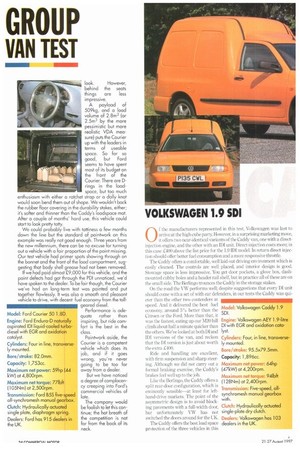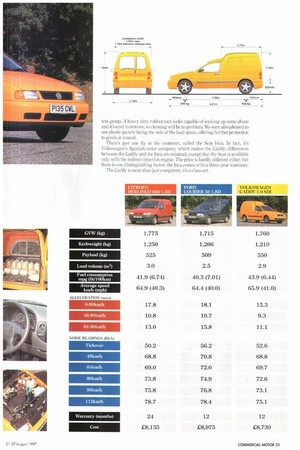VOLKSWAGEN 1.9 SDI
Page 26

Page 27

If you've noticed an error in this article please click here to report it so we can fix it.
0 f the manufacturers represented in this test, Volkswagen was last to arrive at the high-cube party. However, in a surprising marketing move, it offers two near-identical variants of the Caddy van, one with a directinjection engine, and the other with an IDI unit. Direct-injection casts more; in this case .C400 above the list price for the 1.9 ID1 model. In return direct injection should offer better fuel consumption and a more responsive throttle.
The Caddy offers a comfortable, well laid out driving environment which is easily cleaned. The controls are well placed, and interior design is good.
Stowage space is less impressive. You get door pockets, a glove box, dashmounted cubby holes and a header rail shelf, but in practice all of these are on the small side. The Berlingo trounces the Caddy in the storage stakes.
On the road the VW performs well; despite suggestions that every 1)1 unit should come with a set of with ear defenders, in our tests the Caddy was quieter than the other two contenders at speed. And it delivered the best fuel economy. around 5% better than the Citroen or the Ford. More than that, it was the fastest, eating up our M20 hill climb about half a minute quicker than the others. We've looked at both DI and [DI versions of the van, and reckon that the DI version is just about worth the extra £400.
Ride and handling are excellent, with firm suspension and sharp steering. Although we did not carry out a Maximum net power: 64hp formal braking exercise, the Caddy's (47kW) at 4,200rpm. brakes feel well up to the job. Model: Volkswagen Caddy 1.9 SDI.
Engine: Volkswagen AEY 1.9-litre DI with EGR and oxidation catalyst.
Cylinders: Four, in line, transversely mounted.
Bore/stroke: 95.5x79.5mm. Capacity: 1 ,896cc.
Like the Berlingo, the Caddy offers a split rear-door configuration, which is eminently sensible—at least for lefthand-drive markets. The point of the asymmetric design is to avoid blocking pavements with a full-width door, but unfortunately VW has not switched the doors around for the UK.
The Caddy offers the best load space protection of the three vehicles in this
test group. A heavy duty rubber mat looks capable of soaking up some abuse and it's easy to remove, so cleaning will be no problem. We were also pleased to see plastic panels lining the side of the load space, offering further protection to goods in transit.
There's just one fly in the ointment, called the Seat Inca. En fact, it's Volkswagen's Spanish sister company which makes the Caddy; differences between the Caddy and the Inca are minimal, except that the Seat is available only with the indirect-injection engine. The price is hardly different either, but there is one distinguishing factor: the Inca comes with a three-year warranty.
The Caddy is more than just competent, it's a class act.
































































































